| dc.contributor.author | Malasevska, Iveta | |
| dc.contributor.author | Haugom, Erik | |
| dc.contributor.author | Lien, Gudbrand | |
| dc.contributor.author | Hinterhuber, Andreas | |
| dc.contributor.author | Alnes, Per Kristian | |
| dc.date.accessioned | 2023-05-03T09:15:51Z | |
| dc.date.available | 2023-05-03T09:15:51Z | |
| dc.date.created | 2022-01-04T09:14:05Z | |
| dc.date.issued | 2022 | |
| dc.identifier.citation | Managing Sport and Leisure. 2022, . | en_US |
| dc.identifier.issn | 2375-0472 | |
| dc.identifier.uri | https://hdl.handle.net/11250/3065940 | |
| dc.description | © 2022 Informa UK Limited, trading as Taylor & Francis Group.
Dette er en akseptert versjon av en artikkel fra Managing Sport and Leisure. Den publiserte artikkelen finnes her: https://doi.org/10.1080/23750472.2021.2020679/
This is the accepted version of an article published by Managing Sport and Leisure. The full article can be found here: https://doi.org/10.1080/23750472.2021.2020679 | en_US |
| dc.description.abstract | The alpine skiing industry faces a decline in the number of new active skiers, dropouts of the existing active skiers, and a decline in overall participation frequency. Structural leisure constraints can be considered as a form of managerial failure preventing customers from participating in leisure activities. The purpose of this study is to use choice modelling to examine how the marginal willingness to pay for various leisure constraining factors differ and to provide empirical evidence of how pricing could be used as a negotiation instrument to overcome structural leisure constraints. The rationale behind the choice modelling approach is that a respondent chooses from a set of hypothetical scenarios of a product or service that includes various combinations of attribute levels. The findings emphasize that skiing preferences and marginal willingness to pay vary among less frequent, frequent, and very frequent skiers. Price differentiation can be used as an instrument to limit the influence of constraints and help individuals overcome the structural leisure constraints. The study provides valuable implications for practitioners based on an understanding of the price’s impact on individuals’ choices. | en_US |
| dc.language.iso | eng | en_US |
| dc.rights | Attribution-NonCommercial-NoDerivatives 4.0 Internasjonal | * |
| dc.rights.uri | http://creativecommons.org/licenses/by-nc-nd/4.0/deed.no | * |
| dc.subject | leisure constraints | en_US |
| dc.subject | negotiation strategies | en_US |
| dc.subject | willingness to pay | en_US |
| dc.subject | pricing | en_US |
| dc.subject | alpine skiing | en_US |
| dc.title | Managing structural constraints in recreational alpine skiing: a choice modelling approach | en_US |
| dc.type | Peer reviewed | en_US |
| dc.type | Journal article | en_US |
| dc.description.version | acceptedVersion | en_US |
| dc.subject.nsi | VDP::Samfunnsvitenskap: 200 | en_US |
| dc.source.pagenumber | 14 | en_US |
| dc.source.journal | Managing Sport and Leisure | en_US |
| dc.identifier.doi | 10.1080/23750472.2021.2020679 | |
| dc.identifier.cristin | 1974043 | |
| cristin.ispublished | true | |
| cristin.fulltext | original | |
| cristin.qualitycode | 1 | |

